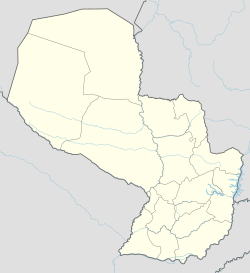You can help expand this article with text translated from the corresponding article in Spanish. (March 2009) Click for important translation instructions.
|
| Katueté | |
|---|---|
| Town | |
 | |
| Coordinates: 24°14′53″S 54°45′27″W / 24.24806°S 54.75750°W / -24.24806; -54.75750 | |
| Country | Paraguay |
| Department | Canindeyú |
| Government | |
| • Mayor | Julio César Brítez (UNACE) |
| Population | |
| • Total | 8,681 |
| Time zone | UTC-3 |

Katueté is a municipality and city of Paraguay that is located in the central area of the Department of Canindeyú. The district was created by law no. 342/94 on May 24, 1994. It is located 362 km from the city of Asunción, on Route 10.
The name of Katueté is attributed to Dr. Alejandro Encina Marín, who on a tour with the owners of the area looking for a suitable site for the creation of an urban center, expressed upon arriving at the place in the Guaraní language "katueté voi, ko ape oî porâta”, to the owners' statement about the benefits of the location of that site.
Geography
The so-called “high zone” has experienced a notable development, from the specific perspective of the physical aspect, it is clearly distinguished, valleys that are very suitable for agricultural activities, it essentially includes flat and undulating terrain, with lands very suitable for agriculture.
It borders to the north with Corpus Christi and Álvarez; to the south with Nueva Esperanza; to the east with Álvarez; and to the west with Corpus Christi and Ybyrarobaná.
Hydrography
In the area there are important tributaries of the Paraná River, the Carapá River, in addition, the well-watered region has numerous water courses in its territory, such as the Tayi Caré streams and the Itabó stream, among other small water tributaries that They irrigate the region.
Climate
It has a subtropical climate, with an annual average of 21°C and a minimum average of 15°C. During the summer, temperatures of up to 41°C are recorded, while in the winter minimum temperatures of up to 0°C are observed. As for rainfall, there is abundant rain, with an average that ranges between 1,600 and 1,700 mm, with the month of May being the rainiest and the month of June the driest.
Demographics
According to the data provided by the DGEEC, its total population amounts to 10,912 inhabitants, of which 5,729 are men and 5,184 women. Carrying out a relationship with the total population of the district, it can be seen that 70% of the population is settled in the rural area.
Economy

These lands are fertile for cultivation, and are mostly inhabited by Brazilian settlers. All these lands belonged to La Industrial Paraguaya, and were acquired by the Lunardelli group in the late sixties.
In the area the main crop is soy, wheat and cassava, constituting an important link in Paraguayan agricultural production and also a center for the development of a new cultural component, for the presence of the so-called brasiguayos, Paraguayan descendants of Brazilian settlers settled in the area.
Several sawmills operate in the area. Cassava processing plants operate in Katueté with private Brazilian investment. The average raw material storage capacity ranges between 200 tons per day. Other minor industries operate discreetly in the districts of the region.
Infrastructure
The main land communication route is Route PY03, which connects it with Salto del Guairá and Asunción, and with other towns in the department and the country. 70% of the roads are terraced and 30% paved. It has a health center and does not include dispensaries in indigenous colonies. A large part of the population of Brazilian nationality uses health services in Brazil.
The digitalization of the telephone exchanges of Salto del Guairá, Francisco Caballero Álvarez, Corpus Christi, Nueva Esperanza, Katueté and Curuguaty is enabled. It is benefited from Copaco telephone services and mobile telephone services, it also has several other means of communication and the capital's newspapers reach all places.
Sources
- World Gazeteer: Paraguay – World-Gazetteer.com